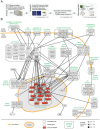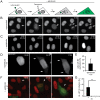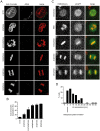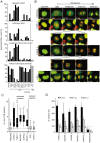Large scale RNAi reveals the requirement of nuclear envelope breakdown for nuclear import of human papillomaviruses
- PMID: 24874089
- PMCID: PMC4038628
- DOI: 10.1371/journal.ppat.1004162
Large scale RNAi reveals the requirement of nuclear envelope breakdown for nuclear import of human papillomaviruses
Abstract
A two-step, high-throughput RNAi silencing screen was used to identify host cell factors required during human papillomavirus type 16 (HPV16) infection. Analysis of validated hits implicated a cluster of mitotic genes and revealed a previously undetermined mechanism for import of the viral DNA (vDNA) into the nucleus. In interphase cells, viruses were endocytosed, routed to the perinuclear area, and uncoated, but the vDNA failed to be imported into the nucleus. Upon nuclear envelope perforation in interphase cells HPV16 infection occured. During mitosis, the vDNA and L2 associated with host cell chromatin on the metaphase plate. Hence, we propose that HPV16 requires nuclear envelope breakdown during mitosis for access of the vDNA to the nucleoplasm. The results accentuate the value of genes found by RNAi screens for investigation of viral infections. The list of cell functions required during HPV16 infection will, moreover, provide a resource for future virus-host cell interaction studies.
Conflict of interest statement
The authors have declared that no competing interests exist.
Figures






Similar articles
-
A central region in the minor capsid protein of papillomaviruses facilitates viral genome tethering and membrane penetration for mitotic nuclear entry.PLoS Pathog. 2017 May 2;13(5):e1006308. doi: 10.1371/journal.ppat.1006308. eCollection 2017 May. PLoS Pathog. 2017. PMID: 28464022 Free PMC article.
-
Translocation of the papillomavirus L2/vDNA complex across the limiting membrane requires the onset of mitosis.PLoS Pathog. 2017 May 2;13(5):e1006200. doi: 10.1371/journal.ppat.1006200. eCollection 2017 May. PLoS Pathog. 2017. PMID: 28463988 Free PMC article.
-
A Ran-binding protein facilitates nuclear import of human papillomavirus type 16.PLoS Pathog. 2021 May 11;17(5):e1009580. doi: 10.1371/journal.ppat.1009580. eCollection 2021 May. PLoS Pathog. 2021. PMID: 33974675 Free PMC article.
-
PML Bodies in Mitosis.Cells. 2019 Aug 14;8(8):893. doi: 10.3390/cells8080893. Cells. 2019. PMID: 31416160 Free PMC article. Review.
-
The Dynamic Nature of the Nuclear Envelope.Curr Biol. 2018 Apr 23;28(8):R487-R497. doi: 10.1016/j.cub.2018.01.073. Curr Biol. 2018. PMID: 29689232 Review.
Cited by
-
Diverse Papillomavirus Types Induce Endosomal Tubulation.Front Cell Infect Microbiol. 2019 May 28;9:175. doi: 10.3389/fcimb.2019.00175. eCollection 2019. Front Cell Infect Microbiol. 2019. PMID: 31192164 Free PMC article.
-
Evidence for Tethering of Human Cytomegalovirus Genomes to Host Chromosomes.Front Cell Infect Microbiol. 2020 Sep 30;10:577428. doi: 10.3389/fcimb.2020.577428. eCollection 2020. Front Cell Infect Microbiol. 2020. PMID: 33117732 Free PMC article.
-
Glycan-induced structural activation softens the human papillomavirus capsid for entry through reduction of intercapsomere flexibility.Nat Commun. 2024 Nov 21;15(1):10076. doi: 10.1038/s41467-024-54373-0. Nat Commun. 2024. PMID: 39572555 Free PMC article.
-
The human papillomavirus oncoproteins: a review of the host pathways targeted on the road to transformation.J Gen Virol. 2021 Mar;102(3):001540. doi: 10.1099/jgv.0.001540. Epub 2021 Jan 11. J Gen Virol. 2021. PMID: 33427604 Free PMC article. Review.
-
HPV-16 virions can remain infectious for 2 weeks on senescent cells but require cell cycle re-activation to allow virus entry.Sci Rep. 2018 Jan 16;8(1):811. doi: 10.1038/s41598-017-18809-6. Sci Rep. 2018. PMID: 29339794 Free PMC article.
References
-
- Doorbar J, Quint W, Banks L, Bravo IG, Stoler M, et al. (2012) The biology and life-cycle of human papillomaviruses. Vaccine 30 Suppl 5 F55–70. - PubMed
-
- Bosch FX, de Sanjose S (2003) Chapter 1: Human papillomavirus and cervical cancer—burden and assessment of causality. J Natl Cancer Inst Monogr (31): 3–13. - PubMed
MeSH terms
Substances
LinkOut - more resources
Full Text Sources
Other Literature Sources

